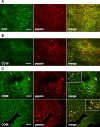Effects of pepsin and pepstatin on reflux tonsil hypertrophy in vitro
- PMID: 30408092
- PMCID: PMC6224077
- DOI: 10.1371/journal.pone.0207090
Effects of pepsin and pepstatin on reflux tonsil hypertrophy in vitro
Abstract
There is evidence that pepsin can aggravate tonsil hypertrophy. Pepstatin is a potent inhibitor of pepsin activity and could protect patients against reflux tonsil hypertrophy by inhibiting pepsin. We examined the effects of pepstatin on the development of tonsil hypertrophy to investigate pepsin's role in the pathogenesis of tonsil lesions. We investigated whether pepstatin suppresses pepsin-mediated lymphocyte proliferation in tonsil hypertrophy. Forty-nine children with tonsil hypertrophy and twenty-two adults with tonsillitis were recruited to the study prior to surgery. Tonsil tissue from each patient was harvested and assessed for changes in the number of lymphocytes and macrophages in the presence of pepsin and pepstatin. We found that the proportions of CD4- and CD14-positive cells were significantly lower (p < 0.05), but that the proportions of CD19- and CD68-positive cells were significantly higher (p < 0.05), in children than in adults. There were significantly more CD4-positive cells after pepsin treatment, but these numbers were reduced by pepstatin. The levels of both interleukin-2 (IL-2) and interferon gamma (IFN-γ) increased significantly in response to pepsin, but were reduced when pepsin was inhibited by pepstatin. The level of IL-10 is reduced in pepsin-treated CD4 cells and the level is restored by pepstatin. IL-2 blocking reduced the increased CD4 cell number by pepsin. But, an additive or a synergic effect is not founded in combined with IL-2 blocking and pepstatin. Pepsin-positive cells did not co-localize with CD20 and CD45 cells, but they were found surrounding CD20- and CD45-positive hypertrophic tonsil cells. Pepsin-positive cells co-localized with CD68-positive cells. It is probable that pepsin from extraesophageal reflux aggravates tonsil hypertrophy and pepstatin exerts a protective effect by inhibiting pepsin activity.
Conflict of interest statement
The authors have declared that no competing interests exist.
Figures




References
-
- Choi KY, Lee BS, Kim JH, Kim JJ, Jang Y, Choi JW, et al. Assessment of Volatile Sulfur Compounds in Adult and Pediatric Chronic Tonsillitis Patients Receiving Tonsillectomy. Clin Exp Otorhinolaryngol. 2018;11(3):210–5. Epub 2018/05/04. doi: 10.21053/ceo.2017.01109 ; PubMed Central PMCID: PMC6102335. - DOI - PMC - PubMed
-
- Kim MJ, Bae SH, Lee SM, Lee KH, Kim DK. Effect of Adenotonsillectomy on Attention in Korean Children With Sleep-Disordered Breathing. Clin Exp Otorhinolaryngol. 2018;11(3):199–204. Epub 2018/05/19. doi: 10.21053/ceo.2018.00115 ; PubMed Central PMCID: PMC6102337. - DOI - PMC - PubMed
-
- Sugiyama M, Sasaki T, Nakai Y, Otani S, Kinoshita Y. Studies on the cell-mediated immune response of tonsillar lymphocytes with regard to the clinical course and patient's age. Int J Pediatr Otorhinolaryngol. 1982;4(3):193–208. Epub 1982/08/01. . - PubMed
Publication types
MeSH terms
Substances
LinkOut - more resources
Full Text Sources
Other Literature Sources
Medical
Research Materials
Miscellaneous

